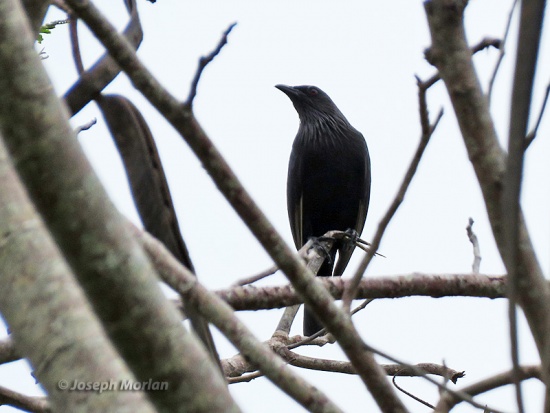
Photo © by Joseph Morlan
Mount Austen, Guadalcanal, Solomon Islands, 19 September 2019
Alternative name: Large Glossy Starling
- Aplonis grandis
Identification

Photo © by djringer
Buka Island, Autonomous Region of Bougainville, Papua New Guinea, 22 September 2006
27cm (10½ in.). A large Starling with a medium-length tail
- Brown primaries and secondaries, paler when worn (forming wing patch in flight)
- Gray throat hackles.
- Mostly black plumage, iridescent purple on head, throat and upper breast, glossy green on mantle, oily green on breast and bluish-purple on rest of underparts
- Red eye (sometimes red-brown or brown)
- Black legs and bill
Variations
A. g. macrura has a longer tail and shorter throat hackles; A. g. malaitae has more green gloss and a whitish eye Sexes similar. Juveniles are duller than adults with duller brown primaries.
Distribution
Found on Bougainville (Papua New Guinea) and the Solomon Islands. Common in most of its range.
Taxonomy
May form a superspecies with San Cristobal Starling.
Subspecies
There are 3 subspecies[1]:
- A. g. grandis:
- Solomon Islands (Bougainville, Choiseul, Santa Isabel, New Georgia Group and Florida Islands)
- A. g. macrura:
- Guadalcanal (Solomon Islands)
- A. g. malaita:
- Malaita (Solomon Islands)
Habitat
Moist lowland forest, secondary growth, cleared areas, villages with tall trees. Generally below 750m but on Guadalcanal up to 1200m.
Behaviour
Usually seen singly or in pairs, sometimes in small flocks. Forages high in tall trees.
Diet
Feeds on fruit, takes also some insects.
Breeding
Breeding from May to September on Bougainville. A solitary nester, presumably monogamous. The nest is a bulky mass made of twigs, dry leaves, moss and grass. It has a side entrance and is placed in a tree fork or in a cavity at the end of a broken branch. Lays 2 - 3 eggs.
Movements
A resident species.
References
- Clements, J. F., T. S. Schulenberg, M. J. Iliff, S. M. Billerman, T. A. Fredericks, B. L. Sullivan, and C. L. Wood. 2019. The eBird/Clements Checklist of Birds of the World: v2019. Downloaded from http://www.birds.cornell.edu/clementschecklist/download/
- Del Hoyo, J, A Elliott, and D Christie, eds. 2009. Handbook of the Birds of the World. Volume 14: Bush-shrikes to Old World Sparrows. Barcelona: Lynx Edicions. ISBN 978-8496553507
- BirdForum Member observations
- Craig, A. & Feare, C. (2019). Brown-winged Starling (Aplonis grandis). In: del Hoyo, J., Elliott, A., Sargatal, J., Christie, D.A. & de Juana, E. (eds.). Handbook of the Birds of the World Alive. Lynx Edicions, Barcelona. (retrieved from https://www.hbw.com/node/60838 on 1 December 2019).
- Dutson, G. (2011) Birds of Melanesia, Christopher Helm, London.
- Gregory, P. (2017) Birds of New Guinea, Including Bismarck Archipelago and Boughainville. Lynx Edicions, Barcelona.
Recommended Citation
- BirdForum Opus contributors. (2025) Brown-winged Starling. In: BirdForum, the forum for wild birds and birding. Retrieved 13 May 2025 from https://www.birdforum.net/opus/Brown-winged_Starling



